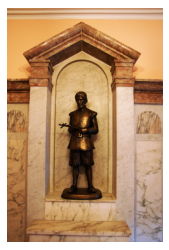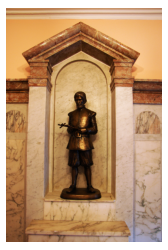
© Lorem ipsum dolor sit Nulla in mollit pariatur in, est ut dolor eu eiusmod lorem 2013
John was born into a well-connected family in 1579; the son of Sir
Walter Ogilvie, baron of Drum-na-Keith, whose father, James, had
been Treasurer to Mary Queen of Scots. His mother was Lady Agnes
Elphinstone, who died in 1582, when John was only 3 years old. The
family tree is said to have stretched back to William, King of Scotland,
and Queen Margaret, herself later to be made a Saint.
Like many, the Ogilvies were once staunch Catholics but the
Reformation of 1560 had changed the face of Scotland. Just 20 years
before John Ogilvie’s birth, John Knox had succeeded in switching
Scotland’s state religion from Catholicism to Calvanism, later known
as Presbyterianism, and there were fierce purges to stamp out the
Catholic faith.
The saying of Mass was outlawed, priests were banished, and anyone suspected of being a
Papist could be thrown into prison. Even being found with a rosary or crucifix would lead to
punishment. And, yet, brave souls were still prepared to risk danger, imprisonment and
death to practise their faith in secret.
Although some of the nobility, particularly in the northern part of the country, may have
retained Catholic leanings few were willing to show them for fear of losing their lands, their
wealth, and their status. So, young Ogilvie was brought up a Calvinist.
Such was the fear of the influence from still Catholic Europe that permits had to be granted
for travelling abroad, and Sir Walter Ogilvie obtained one for his son, who set off from home
in 1592, aged 13, to further his education, his experience of life, so he would be better
equipped to play what his father hoped would be a prominent role in Scottish affairs for his
first born. He travelled with his Uncle George Elphinstone. But the path of life that John was
to take was not the one that his family had planned.
He travelled widely and studied, in France, Germany and Italy, and listened to scholars both
Calvinist and Catholic discussing religion. That proved a source of inspiration, and at the age
of 17 he converted to Catholicism. It was the first of many brave moves.
We can only imagine the torment this must have caused. How had he broken the news to
his family? It must have caused him great anguish and led to all financial support to him
being cut off. It is not thought he ever saw them again.
The Early Years
St John Ogilvie



© Lorem ipsum dolor sit Nulla in mollit pariatur in, est ut dolor
eu eiusmod lorem 2013
St John Ogilvie
The Early Years
John was born into a well-connected family in 1579; the son of
Sir Walter Ogilvie, baron of Drum-na-Keith, whose father,
James, had been Treasurer to Mary Queen of Scots. His mother
was Lady Agnes Elphinstone, who died in 1582, when John was
only 3 years old. The family tree is said to have stretched back
to William, King of Scotland, and Queen Margaret, herself later
to be made a Saint.
Like many, the Ogilvies were once staunch Catholics but the
Reformation of 1560 had changed the face of Scotland. Just 20
years before John Ogilvie’s birth, John Knox had succeeded in
switching Scotland’s state religion from Catholicism to
Calvanism, later known as Presbyterianism, and there were
fierce purges to stamp out the Catholic faith.
The saying of Mass was outlawed, priests were banished, and
anyone suspected of being a Papist could be thrown into
prison. Even being found with a rosary or crucifix would lead
to punishment. And, yet, brave souls were still prepared to risk
danger, imprisonment and death to practise their faith in
secret.
Although some of the nobility, particularly in the northern part
of the country, may have retained Catholic leanings few were
willing to show them for fear of losing their lands, their wealth,
and their status. So, young Ogilvie was brought up a Calvinist.
Such was the fear of the influence from still Catholic Europe
that permits had to be granted for travelling abroad, and Sir
Walter Ogilvie obtained one for his son, who set off from home
in 1592, aged 13, to further his education, his experience of
life, so he would be better equipped to play what his father
hoped would be a prominent role in Scottish affairs for his first
born. He travelled with his Uncle George Elphinstone. But the
path of life that John was to take was not the one that his
family had planned.
He travelled widely and studied, in France, Germany and Italy,
and listened to scholars both Calvinist and Catholic discussing
religion. That proved a source of inspiration, and at the age of
17 he converted to Catholicism. It was the first of many brave
moves.
We can only imagine the torment this must have caused. How
had he broken the news to his family? It must have caused him
great anguish and led to all financial support to him being cut
off. It is not thought he ever saw them again.






















